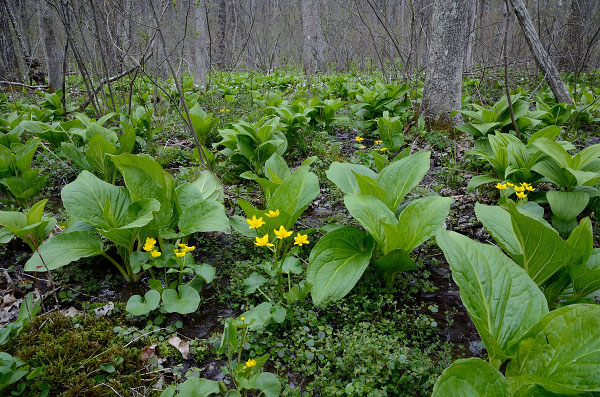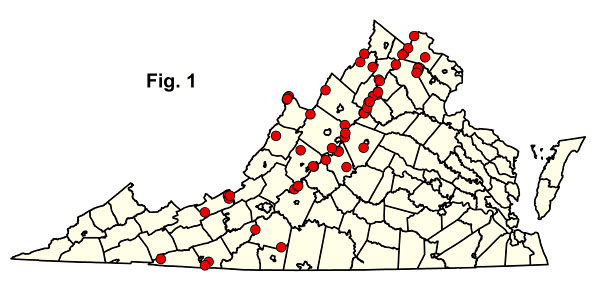
 保育與休閒部
保育與休閒部 保育。保護。享受。
 保育與休閒部
保育與休閒部  目錄
目錄山脈/皮埃蒙特滲漏沼澤
這群飽滿的森林濕地佔據了平緩斜坡的溪頭水、大型泉水滲漏,以及峽谷和溪地底的側面區域,地下水在斜坡底部出現的地下水。這些社區本地分佈在西弗吉尼亞州,從最低高度到超過 1200 m(4,000 英尺)。棲息地通常具有凹凸的微型地形,覆蓋著巨石、螺旋和碎石的流水;編織的滲漏和溪流道;青苔覆蓋的山丘;以及充滿泥漿的凹陷。在水文學上,這些棲息地分為 " 地下水斜坡濕地," 其中在地面排出的滲漏是以溪流的形式排出。它們與某些流域濕地不同,這些濕地嚴格被坐落地下水飽和,並支持有點類似的植被植物(如需更多信息,請參閱山脈沉積沼澤和池塘生態組描述)。六種社區類型沿著土壤和地下水化學、海拔和地理的梯度分開。
The Central Appalachian Basic Seepage Swamp occurs at elevations up to 975 m (3,200 ft) in areas underlain by metabasalt (greenstone) and other mafic rocks, base-rich granitic rocks, calcareous shale, and limestone. The type is most common on the northern Blue Ridge but is found occasionally in the Ridge and Valley province, and rarely in the western Piedmont. Soils range from strongly acidic to circumneutral, with moderately high calcium and magnesium levels. Overstory composition is mixed, with variable combinations of red maple (Acer rubrum), white ash (Fraxinus americana), black ash (Fraxinus nigra), tulip-tree (Liriodendron tulipifera), and sweet birch (Betula lenta var. lenta). Yellow birch (Betula alleghaniensis) is an important tree at some sites. Spicebush (Lindera benzoin var. benzoin) is usually the most abundant shrub. Herbaceous cover is typically lush, and often features patch-dominance of skunk cabbage (Symplocarpus foetidus), American false-hellebore (Veratrum viride), and/or sedges (especially Carex bromoides ssp. bromoides and Carex prasina). Additional characteristic herbs include marsh marigold (Caltha palustris var. palustris), golden saxifrage (Chrysosplenium americanum), swamp saxifrage (Micranthes pensylvanica), lettuce saxifrage (Micranthes micranthidifolia), marsh blue violet (Viola cucullata), golden ragwort (Packera aurea), orange jewelweed (Impatiens capensis), water-hemlock (Cicuta maculata var. maculata), large purple fringed orchid (Platanthera grandiflora), and various ferns. Most Virginia populations of the globally rare plants bog bluegrass (Poa paludigena) and glade spurge (Euphorbia purpurea), as well as of the globally rare Blue Ridge Mountain amphipod (Stygobromus spinosus), are associated with these basic-soil swamps.
Acidic analogues of the preceding type occur in the same region on soils weathered from sandstone, quartzite, or base-poor granitic rocks. Abundant Sphagnum mats and groundwater with low pH are typical habitat features. Soils are very strongly to extremely acidic, with low base status. Composition is variable over the range of this group. Red maple (Acer rubrum), blackgum (Nyssa sylvatica), and tulip-poplar (Liriodendron tulipifera), are the most typical trees, while winterberry (Ilex verticillata), swamp azalea (Rhododendron viscosum var. viscosum), highbush blueberries (Vaccinium corymbosum and Vaccinium fuscatum) are abundant shrubs. Pitch pine (Pinus rigida) is a characteristic tree of some Ridge and Valley stands. Skunk-cabbage (Symplocarpus foetidus) and American false-hellebore (Veratrum viride) may be as dominant in these communities as in Mountain / Piedmont Basic Seepage Swamps; herbs and low shrubs more abundant in or characteristic of acidic swamps include cinnamon fern (Osmundastrum cinnamomeum), bristly dewberry (Rubus hispidus), kidneyleaf grass-of-parnassus (Parnassia asarifolia), yellow fringed orchid (Platanthera ciliaris) small green wood orchid (Platanthera clavellata), common tree clubmoss (Lycopodium obscurum), white-edged sedge (Carex debilis), and long sedge (Carex folliculata). Like the very similar Coastal Plain / Piedmont Acidic Seepage Swamps, these communities support populations of the federally listed swamp-pink (Helonias bullata).

Seepage swamps above 975 m (3,200 ft) elevation are compositionally allied with more northern vegetation types. Eastern hemlock (Tsuga canadensis), yellow birch (Betula alleghaniensis), and red maple (Acer rubrum) are the most common trees. Locally, red spruce (Picea rubens) or eastern white pine (Pinus strobus) may be co-dominants. Shrub layer composition and density is variable; deciduous hollies (Ilex verticillata and Ilex montana), several blueberries (particularly Vaccinium corymbosum, Vaccinium simulatum, and Vaccinium angustifolium), great rhododendron (Rhododendron maximum), mountain laurel (Kalmia latifolia), speckled alder (Alnus rugosa), and witch hazel (Hamamelis virginiana var. virginiana) may be abundant. Characteristic herbs of these swamps include marsh marigold (Caltha palustris var. palustris), star sedge (Carex echinata ssp. echinata), finely-nerved sedge (Carex leptonervia), eastern rough sedge (Carex scabrata), three-seeded sedge (Carex trisperma), slender wood reedgrass (Cinna latifolia), tall flat-topped white aster (Doellingeria umbellata var. umbellata), spinulose wood fern (Dryopteris carthusiana), slender mannagrass (Glyceria melicaria), whorled wood aster (Oclemena acuminata), cinnamon fern (Osmundastrum cinnamomeum), American false-hellebore (Veratrum viride), and smooth white violet (Viola mackloskeyi var. pallens). Communities in this group are naturally rare due to the scarcity of flat or gentle, wet habitats in the higher Appalachians.
所有滲水沼澤都是容易受水文干擾的小區域社區。海豹在幾個地點已部分摧毀了這些沼澤的精緻例子,而且由於大量的大量蜂草死亡率受到影響,由於大量由於大量蜂草羊毛蟲(Adelges tsugae)的爆發而受到影響。目前,中部阿巴拉契亞基本滲漏沼澤的豐富灰分正在受到祖母綠灰褐藻爆發的嚴重死亡率。
參考文獻:阿拉德和倫納德(1943),卡爾(1939),弗萊明(1999),弗萊明(2002 b),弗萊明和范阿爾斯汀(1990,弗萊明和庫林(2001),拉溫斯基等。(1994),拉溫斯基等。(1996)。 © DCR-DNH,加里 ·P· 弗萊明。
© DCR-DNH,加里 ·P· 弗萊明。

 下載下面列出的每種社群類型的組成摘要統計資料表。
下載下面列出的每種社群類型的組成摘要統計資料表。

